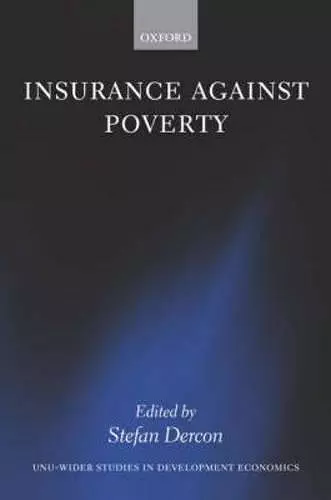Insurance Against Poverty
Format:Hardback
Publisher:Oxford University Press
Published:11th Nov '04
Currently unavailable, and unfortunately no date known when it will be back

Poor people in developing countries are often affected by droughts, floods, illness, crop failure, job loss, and economic downturns. Much of their energy goes into coping with these shocks and into day-to-day survival. While insurance and credit markets, combined with widespread social security, provide an important cushion against poverty in rich countries, the need for immediate survival may lock the poor into persistent poverty in developing countries. The poor in developing countries do have informal mechanisms to cope with risk and misfortune. These are based on income diversification, risk avoidance, self-insurance by saving together with family, and community-based mutual assistance. Nevertheless, the scope of these mechanisms remains limited. Repeated individual-specific shocks such as illness or pests, or covariate risks associated with drought, flood, or recession, undermine the ability of individuals and their families to cope with risk. We now know much more about vulnerability to risk and how poor people cope. Even more importantly, we have learned much about the large long-term consequences of these risks, which condemns many to persistent poverty and excludes them from economic growth. But there is much that can be done. The micro-level studies that underpin this book offer new insights on how effective public action could be more effective in protecting the vulnerable against persistent poverty. Policy should focus on providing a comprehensive menu of ex-ante and post-crisis protection mechanisms, including new forms of insurance, savings, safety nets, and the means to strengthen the poor's asset base. Local communities have a big role to play: public funds should not be used to replace indigenous community-based support networks; rather they should be used to build on the strengths of these networks to ensure broader and more effective protection. With numerous thematic chapters and case studies of both best practice and of failure, from a mix of low-income and middle-income countries across the developing world, this book evaluates alternatives in widening insurance and protection provision, and makes an important contribution to the topical field of insurance and risk.
"To conclude, this book provides a set of useful answers on crucial policy questions and deserves wide reading. It also points to the potential for a rich agenda of research questions for development economists to address" * Flore Gubert, IRD, DIAL, Paris, Journal of African Economies, 16 (1): 172175, September 2006 *
"The volume begins with a very informative and well-thought-out review essay on risk and insurance by Dercon himself. This overview would be a useful addition to syllabi for advanced undergraduate or graduate development economics courses and to anyone wanting to get up to speed on the vast literature devoted to the topic. More generally, the essays in this volume will probably be most useful to scholars interested in a particular topic or in evidence and information for a particular country." * Anna Paulson, Federal Reserve Bank of Chicago, Economic Development and Cultural Change, 55:625627, April 2007 Reserve Bank of Chicago, Economic Development and Cultural Change, 55: 625627, April 2007 *
This is a rich and scholarly collection of papers that could help design a more effective poverty alleviation strategy - especially in a world characterized by diverse and pervasive risks against which large segments of the population are often defenceless. * Gaiha, Development and Change *
ISBN: 9780199276837
Dimensions: 240mm x 162mm x 30mm
Weight: 869g
488 pages